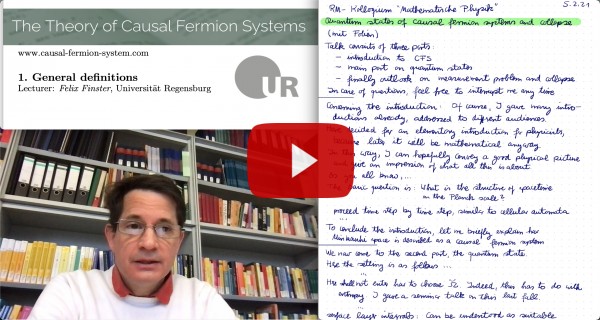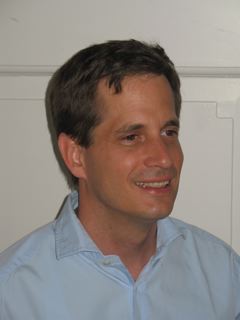The Theory of Causal Fermion Systems
The Continuum Limit
Prerequisites
Continue Reading
The Continuum Limit

The analysis of the continuum limit is a systematic procedure for evaluating the Euler-Lagrange equations for causal fermion systems constructed in Minkowski space in the limit $\varepsilon \searrow 0$ when the ultraviolet regularization is removed. It makes it possible to rewrite the dynamics as described by the causal action principle in terms of an interaction of Dirac particles and anti-particles with classical bosonic fields. We now outline the method (for details see [cfs16]).
- Causal fermion systems in the presence of external potentials
- The light-cone expansion and its regularization
- The formalism of the continuum limit
- The general current formalism
- Description of interacting systems
The results of the continuum limit are summarized in the physics sections here.
Causal Fermion Systems in the Presence of External Potentials
The construction of causal fermion systems in Minkowski space can be extended to the Dirac equation in the presence of an external potential ${\mathcal{B}}$, i.e. for the Dirac equation
\[ \big( i \gamma^j \partial_j + {\mathcal{B}} – m \big) \psi = 0 \:. \]
Here ${\mathcal{B}}$ could be an electromagnetic potential (${\mathcal{B}}=\gamma^j A_j$), a Yang-Mills potential, a gravitational potential (in which case ${\mathcal{B}}$ is a first order differential operator), but it could also have a more general form (for example an integral operator). In any case, the potential does not need to satisfy any field equations. It can be chosen arbitrarily. The Dirac equation should be understood merely as a mathematical tool to describe collective variations of all the wave functions.
The next step is to choose a subspace $\H$ of the solution space. Once this has been done, the causal fermion system can be constructed just as without potential (by choosing a regularization operator, computing the local correlation operators $F^\varepsilon(x)$ and taking the push-forward $\rho:=(F^\varepsilon)_* \mu$). In order to choose $\H$, it is most convenient to first construct the kernel of the fermionic projector as a symmetric bi-solution of the Dirac equation
\[ \Big( i \gamma^j \frac{\partial}{\partial x^j} + {\mathcal{B}} – m \Big) P(x,y) = 0 \:, \]
and to take $\H$ as the image of the corresponding fermionic projector. If the potential ${\mathcal{B}}$ is time-dependent, the solutions of the Dirac equation contain “mixtures” of positive and negative frequencies. As a consequence, there is no canonical choice of $\H$ which would correspond to the fermionic vacuum. Different choices of $\H$ correspond to different physical systems, which for different observers may or may not contain particles and anti-particles. Mathematically, this freedom can be expressed by saying that $P(x,y)$ can be a general bi-distribution of Hadamard form.
The construction of $P(x,y)$ in external potentials has been studied perturbatively in [sea97, FG09, norm14] and non-perturbatively in [finite13, infinite13, hadamard15] (see also [cfs16, Section 2.1]). One conclusion from this analysis which is of interest independent of the context of causal fermion systems is that, working globally in spacetime, there is a way to distinguish a unique subspace $\H$ which generalizes the negative-energy subspace in the Minkowski vacuum. The construction uses the so-called fermionic signature operator and the mass oscillation property. It has been applied to various spacetimes (see for example [drum14, rindler16, planewave16, sigbh18, desitter19]).
The Light-Cone Expansion and its Regularization
The next step is to analyze the singularity structure of the kernel of the fermionic projector on the light cone. To this end, one performs the so-called light-cone expansion of the form
$\displaystyle P(x,y) = \sum_{n=-1}^\infty$ (line integrals over derivatives of potentials) $\times \,T^{(n)}$ ,
where the factors $T^{(n)}$ become less and less singular on the null cone if $n$ increases. In curved spacetime, the similar expansion is called Hadamard expansion. In Minkowski space, the expansion is performed explicitly in [light98] (see also [cfs16, Section 2.2]).
It is a subtle question how to regularize the light-cone expansion. It turns out that, restricting attention to the leading order in $\varepsilon^2/(y-x)^2$, the regularization can be described with the following rules (see [pfp06, Chapter 4] or [cfs16, Chapter 2]; for the derivation see [pfp06, Appendix D] or [cfs16, Appendix F]):
- The potentials and their derivatives remain unchanged.
- The regularization of the factors $T^{(n)}$ is described symbolically by replacements
\[ m^p \,T^{(n)} \rightarrow m^p\, T^{(n)}_{[p]} \]
(thus the parameter $p$ counts the power in the mass of the corresponding Dirac particles). The restriction to the leading order in $\varepsilon^2/(y-x)^2$ is justified in the formalism of the continuum limit below. Thus the regularized light-cone expansion has the form
$\displaystyle P^\varepsilon(x,y) = \sum_{n=-1}^\infty \sum_{p=0}^\infty$ (line integrals over derivatives of potentials) $\times \,T^{(n)}_{[p]}$ .
We remark that, in curved spacetime, the corresponding regularized Hadamard expansion is derived in [reghadamard17].
The Formalism of the Continuum Limit
The next task is to compute and evaluate the Euler-Lagrange equations. Here we make use of the fact that, up to zeros in the spectrum, the operator product $yx$ has the same eigenvalues and algebraic multiplicities as the closed chain
\[ A^\varepsilon_{xy} := P^\varepsilon(x,y)\, P^\varepsilon(y,x) \]
(→ kernel of the fermionic projector). Therefore, the eigenvalues $\lambda^{xy}_1, \ldots, \lambda^{xy}_{2n}$ of this matrix determine the Lagrangian as well as the kernel $Q(x,y)$ in the Euler-Lagrange equations
\[ \int_M \text{Tr}\big( Q^\varepsilon(x,y)\: \delta P^\varepsilon(y,x) \big)\: d\rho(y) = 0 \:. \]
Evaluating these equations, one finds that in general they diverge as $\varepsilon \searrow 0$. The reason is that $Q^\varepsilon(x,y)$ develops singularities on the light cone. The Euler-Lagrange equations imply that these divergent terms must vanish. In this way, one gets equations for each order of the singularity on the light cone. This procedure can be carried out consistently, if one neglects all contributions
of higher order in $\displaystyle \frac{\varepsilon}{|\vec{y}-\vec{x}|}$ and $\displaystyle \frac{\varepsilon}{l_{\text{macro}}}$ ,
where $l_{\text{macro}}$ denotes the length scales of macroscopic physics (i.e. Compton scale and larger). Restricting attention to variations $\delta P(y,x)$ which vanish unless $|\vec{y}-\vec{x}| \gg \varepsilon$ (for details see [cfs16, Section 3.5.2]), the Euler-Lagrange equations can be evaluated weakly on the light cone with contraction rules and integration-by-parts rules (see [pfp06, Section 4.5] or [cfs16, Section 2.4]). In this way, the Euler-Lagrange equations give rise to conditions for currents, energy-momentum tensors and curvature. These conditions are the effective field equations obtained in the continuum limit.
A-priori, the above procedure depends on the chosen regularization. As a consequence, it is a-priori not clear whether and how the effective field equations depend on the regularization. In order to analyze this question systematically, one considers a large class of regularizations and studies the corresponding effective field equations (method of variable regularization; see [pfp06, Section 4.1] or [cfs16, Section 1.2]). The result of this analysis is that the structure of the field equations as well as the scaling behavior in $\varepsilon$ is robust to the regularization details. The precise form of the resulting coupling constants, the masses of the gauge bosons, and the mixing angles, however, do depend on the regularization scheme. In other words, using the concept that the regularization describes the unknown microstructure of spacetime, these parameters cannot be determined due to our lack of knowledge on the structure of spacetime on the Planck scale. Therefore, these parameters are taken as empiric parameters of the effective macroscopic theory.
The General Current Formalism
In order to get into the position to analyze corrections systematically, in [FF25] the so-called current formalism is developed. It allows to rewrite the linearized field equations in Minkowski space in terms of a hierarchy of tensorial equations of increasing rank.
Description of Interacting Systems
In the analysis of the continuum limit, the bosonic potentials are treated as external (i.e. a-priori given) potentials. The continuum limit gives the effective field equations which these potentials must satisfy. Putting together the Dirac equation and the effective field equations, one get a system of nonlinear partial differential equations which describe the mutual interaction of fermionic and bosonic matter via classical bosonic fields.
The results of the continuum limit are summarized in the physics sections here. Moreover, there is a video on the causal perturbation expansion and light-cone expansion from the 2016 spring school.

Felix Finster
Author